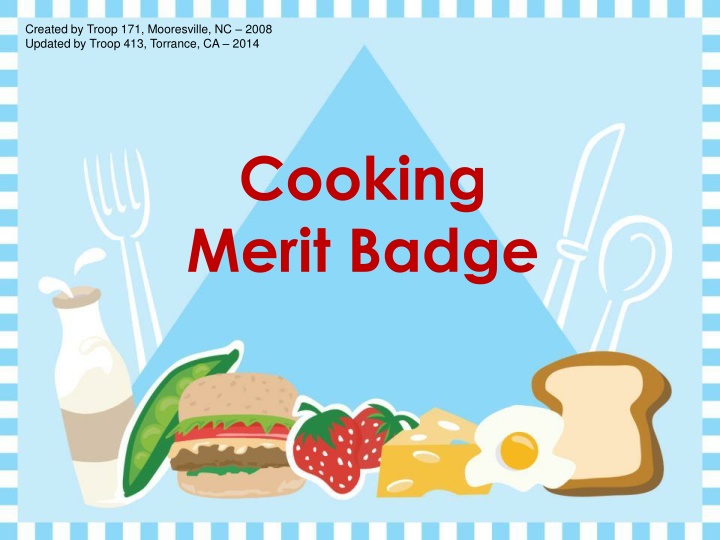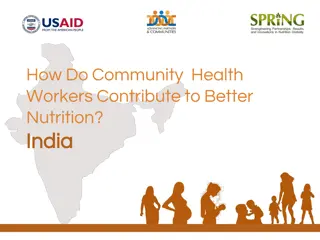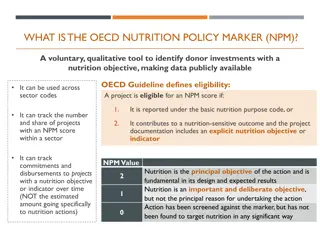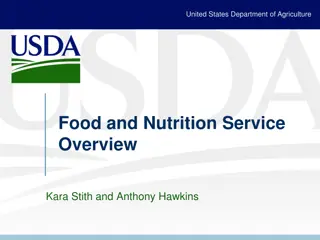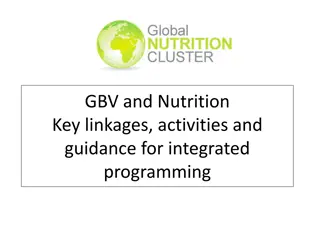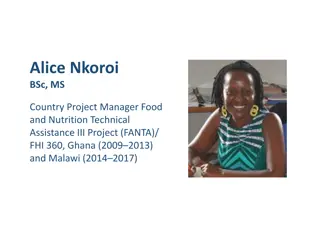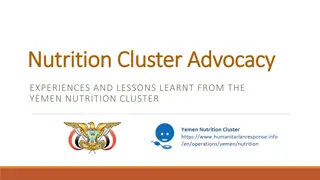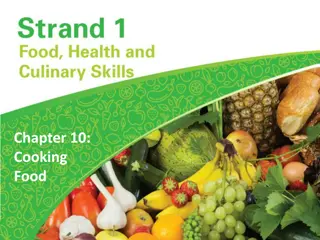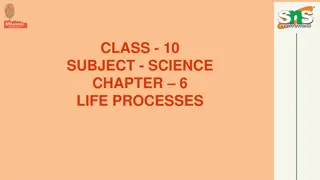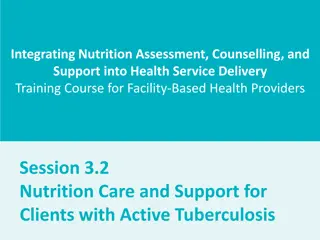Cooking Safety and Nutrition Guide for Beginners
Explore the essentials of cooking safety, nutrition, and food preparation techniques in this comprehensive guide created by Troop 171, Mooresville, NC in 2008 and updated by Troop 413, Torrance, CA in 2014. Learn about common cooking injuries, heat sources, sharp instrument usage, food safety practices, and food-borne illnesses to ensure a safe and enjoyable cooking experience.
Uploaded on Sep 11, 2024 | 0 Views
Download Presentation

Please find below an Image/Link to download the presentation.
The content on the website is provided AS IS for your information and personal use only. It may not be sold, licensed, or shared on other websites without obtaining consent from the author.If you encounter any issues during the download, it is possible that the publisher has removed the file from their server.
You are allowed to download the files provided on this website for personal or commercial use, subject to the condition that they are used lawfully. All files are the property of their respective owners.
The content on the website is provided AS IS for your information and personal use only. It may not be sold, licensed, or shared on other websites without obtaining consent from the author.
E N D
Presentation Transcript
Created by Troop 171, Mooresville, NC 2008 Updated by Troop 413, Torrance, CA 2014 Cooking Merit Badge
Basics of Cooking Safety Nutrition Reading Food Labels Meal Preparation & Planning
Common Cooking Injuries Burns and Scalds Cuts from sharp instruments Choking
Heat Sources Do not leave a lit stove unattended. Dress appropriately when cooking; try not to wear loose clothing such as an open sweater or open jacket. Keep stove and oven area clean. Do not keep towels, oven mitts, or pot holders close to heat source.
Sharp Instruments Always use sharp knives. A sharp knife requires less pressure in cutting than a dull knife does, and your hand is less likely to slip. Cut correctly. Don t hold something in your hand when cutting it. Use a large cutting board. Curl your fingers under when holding food and cut away from you. Keep your fingers away from the blade. Keep your eyes on your cutting. It s easy to get distracted when preparing meals. Never catch a falling knife. Let it fall, pick it up, and wash it.
Food Safety Keep cold foods cold. Keep hot foods hot. Make certain safety seals on food in jars, containers etc. are intact. Freeze meat or poultry that will not be used within 2-3 days. Refrigerate any leftovers and discard if not eaten within three days or more.
Food Safety Meats and dairy Items must be kept cold before use. Meat removed from wrapper must be kept separate. Meat should be cooked before it is no longer cool. Any cooked foods need to be properly stored and refrigerated to eliminate risks of growing bacteria.
Food-borne Illnesses C. jejuni (Campylobacter jejuni) from contaminated water, raw or unpasteurized milk, raw or undercooked meat, poultry, or shellfish. Botulism (Clostridium botulinum) this is a deadly disease. Ingestion of bacteria. Cryptosporidium disease spreads most frequently by public pools, lakes, hot tubs, and contaminated food. E. Coli (Escherichia Coli) bacteria that attacks the intestinal tract. Hepatitis A spreads primarily by improper handing of food, consumption of contaminated food or water, and human-to-human contact.
Food-borne Illnesses Listeria monocytogenes deadly infection can be spread from contaminated ready-to-eat foods such as hot dogs, deli meats, sausage; soft cheeses made with unpasteurized milk; and raw foods. Norovirus found in contaminated food, water, or surfaces, and from human waste, including vomit. Salmonella bacteria linked to raw eggs, poultry, and meat; unpasteurized milk and juice; cheese and seafood. Staphylococcal Aureau bacteria thrives on protein. It can be passed from person to person through improper food handling and cannot be destroyed by cooking.
Food-Related Conditions Allergies could be life threatening. The immune system mistakes a food protein as a threat and attacks it. Lactose intolerance people with this condition are not able to digest lactose, a type of sugar in dairy products. Celiac disease bad reactions to gluten (wheat, rye, barley and sometimes oats) create damage to the lining of the small intestine so your body cannot absorb the nutrients from the foods you eat. Non-celiac gluten sensitivity eating gluten makes these people not feel good. Diabetes the body has trouble regulating its blood- sugar levels.
Nutrition Food Groups
MyPlate Food Guide Steps to a healthier you. What are the food groups?
Grains Two subgroups in Grain Whole Grains are complex carbohydrates. Provide energy and stamina for the body. Examples are whole wheat bread, oatmeal, brown rice. Good source of fiber, iron and many B vitamins. These grains take the body longer to process. Good hiking food. Refined Grains are milled and processed. All of the bran, many vitamins and nutrients are removed. They are enriched with vitamins, but not the bran. Examples are noodles, rice, pasta, macaroni, white flour.
Vegetables Vary your veggies Fresh is best, then frozen and canned last. Greens broccoli, collard greens, turnip, leafy lettuce. Orange acorn squash, butternut squash, pumpkin. Dried Beans/Peas black eyed peas, garbanzo, lentils, navy bean, soybeans etc. Starchy sweet corn, green peas, lima beans, potatoes Other Vegetables artichokes, asparagus, beets, brussel sprouts, cabbage, cauliflower, celery, cucumbers, eggplant, green beans, green or red peppers, okra and radish.
Fruits Focus on fruits Fruits can be fresh, frozen, canned or dried. Great substitutes for sugary sweets. Berries blueberries, raspberries, strawberries. Citrus oranges, grapefruit, tangerines, pineapple. Melons cantaloupe, honeydew Pitted apricots, avocado, cherries, mangoes, prune Others apples, banana, grapes, kiwi fruit, pears.
Milk Get your calcium rich foods In this group all products are made of milk. Yogurt, cheese, cottage cheese, puddings, ice cream, and cream soups. Use low fast or skim as much as possible, regular milk is very high in calories and fat. Yogurts, sweetened drink/chocolate, strawberry milk high in sugar. Limit to skim to reduce calories.
Protein This group is made up of all meats, fish, poultry, peas, eggs, nuts and seeds. These products supply most of your protein to keep bones and muscles strong. It also provides energy. Utilize lean cuts of meat and poultry. Some meats that are not lean are extremely fattening like bacon, sausage, hotdogs, processed meats. These should be used sparingly.
Oils and Fats Oils are fats that become liquid at room temperature. Most oils are unsaturated fats. Oils from plant sources contain no cholesterol. However a few are high in saturated fats like coconut oil. Solid fats like butter, margarine or shortening stay solid at room temperature. These are very high in calories. Common Oils canola, sunflower, corn, cottonseed, grape seed, olive, peanut, safflower, soybean.
MyPlate Food Guide Created by U.S. Dept Agriculture Types of foods people should eat as well as quantity for a healthy life. Emphasizes fruits; vegetables, whole grains, low fat dairy products, lean meats, poultry, fish, beans, eggs and nuts. Average 12 year old who exercises 30-60 minutes a day should consume about 2,200 calories a day that includes 7 ounces of grains, 3 cups vegetables, 2 cups of fruit, 3 cups of milk and 6 ounces from the meat, fish , poultry, nuts and beans grouping.
Discretionary Calories These are add on calories that most people forget about like butter on a baked potato, cheese on top of french fries, chocolate or strawberry added to milks, gravy on meat and potatoes. A lot of people try to eat better and use lean meats, skim milk etc. However they do not pay attention to the discretionary calories. These can add up to a lot if not watched.
Reading Food Labels
Reading Food Labels The food label is based on a 2,000 calorie diet, but your calorie needs might be different. The label doesn t show a %DV for trans fat or sugars. Choose foods with lower or zero grams of trans fat and sugar.
Reading Food Labels Get more of these Potassium, fiber, vitamins A and C, iron, and calcium. Limit these Trans fat, saturated fat, cholesterol, sodium, and sugars. Food allergens Milk, soy, peanut, wheat, and egg must be specifically listed on the product ingredients list. Shellfish The specific type of shellfish must be listed on the product ingredients list. Nuts The specific type of tree nut must be listed on the product ingredients list.
Meal Preparation
Cooking Methods Baking Cook by dry heat. Boiling Cook in water or other liquid hot enough to bubble. Pan Frying Cook meat in a very hot skillet with a minimum of oil. Simmering Cook in liquid just barely at the boiling point. Steaming Place food on a rack or special device over boiling or simmering water in a covered pan. Microwaving Heat food by converting ordinary electric power into very short radio waves. Grilling Cooking food outside over a fire.
Clean As You Go Keep cooking areas clean at all times. Clean and wipe services as you go. Clean utensils after using for another course, not to spread possible bacteria or germs. Make certain bowls are cleaned before needing them for another part of the meal. Clean pots, soak in water so food does not dry onto surfaces and becomes harder to clean.
Meal Planning At Home Planning and Preparation: When will you be cooking? What types of meals will you need? Who will you cook for? Are there any special dietary needs? Create a menu and shopping list Create a timetable for cooking times
Meal Planning Camp Cooking Planning and Preparation: What is your destination? Length of trip? Time of departure/ how many meals required? How many people are going? Anyone having allergies or diet restrictions? What will the activities be at camp? What time of year is it? Is weight a concern? How will you cook the food?
Meal Planning Camp Cooking Planning and Preparation: Take only what is needed You can slice, chop, and measure out food before. Repackage foods that have a lot of packing papers. Use resealable bags to limit space and remove air. Check all meals/ingredients not to miss anything. Pack food so each meal is easily accessible. Stay organized. Do not forget to pack the recipe and cooking gear.
Meal Planning Trail Cooking Preparation for Camp Cooking: Pack lightly simple planning is most effective. Know the weight of your food. Plan for meals needing no refrigeration. Do you always need to cook? Dry prepackaged foods are great for trail cooking. What kind of stoves are needed? Cost is important, plan efficiently, share meals, share desserts/snacks etc.
Meal Planning Camp Cooking Shopping Do s: Price out goods needed. Read labels, and watch unit price along with product price. Largest container is not always least expensive. Look for store ads for coupons to reduce overall cost for your trip. Sometimes meal plan can change based upon something priced better than something else. Generic store brand products are often as good as name brand.
Careers in the Food Industry Production and Manufacturing Professionals This includes getting your food from the farm, ranch or vineyard to the processing facility where it is prepared for your table. Research and Development Chefs and other food professionals try out new flavor combinations, food additives and packaging processes. Food and Beverage Service Professionals These include the people who work at your favorite restaurant, school cafeteria, cruise ship, etc.. Food and Medicine Professionals Nutritionists advise us on how to eat healthy.
Discussion Questions??
